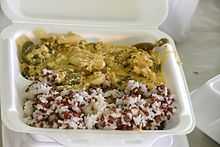Bhutanese cuisine
| Part of a series on the |
| Culture of Bhutan |
|---|
 |
| History |
| People |
| Languages |
| Cuisine |
| Religion |
| Art |
|
Music and performing arts |
| Sport |
|
Bhutanese cuisine (Dzongkha: འབྲུག་ཟས་; Wylie: 'brug-zas) employs a lot of red rice (like brown rice in texture, but with a nutty taste, the only variety of rice that grows at high altitude), buckwheat, and increasingly maize. The diet in the hills also includes chicken, yak meat, dried beef, pork, pork fat and mutton. Soups and stews of meat, rice, ferns, lentils, and dried vegetables spiced with chili peppers and cheese are a favorite meal during the cold seasons. Zow shungo is a rice dish mixed with leftover vegetables. Ema datshi, made very spicy with cheese and chili peppers (akin to chili con queso), might be called the national dish for its ubiquity and the pride that Bhutanese have for it. Other foods include jasha maru, a chicken dish; phaksha paa, thukpa, bathup and fried rice. Popular snacks include momo(dumplings), shakam eezay and liver. Dairy foods, particularly butter and cheese from yak and cow, are also popular, and indeed almost all milk is turned to butter and cheese. Popular beverages include butter tea, tea, locally brewed ara (rice wine) and beer. Spices include cardamom, ginger, chili peppers, thingay (Sichuan pepper), garlic, turmeric and caraway.
When offered food, one says meshu meshu, covering one's mouth with the hands in refusal according to Bhutanese manners, and then gives in on the second or third offer.
-

Bhutanese national dish Ema datshi (ཨེ་མ་དར་ཚིལ།) and rice (mix of bhutanese red rice and white rice).
-
Cooking jasha maru, a traditional dish consisted of minced chicken, tomatoes and other ingredients
-

Jasha tshoem, Bhutanese chicken curry
-

Bhutanese chili peppers in Thimphu market.
See also
- Ara (drink)
- Bhutanese red rice
- Dal
- Ema datshi ཨེ་མ་དར་ཚིལ།(also spelled "Ema Datse")
- Ngathrek Golop Lhakpa
- Tsheringma tea
- Yak butter
References
- Rennie, Frank; Mason, Robin (2008.) Bhutan: ways of knowing. Information Age Publishing, Inc. ISBN 978-1-59311-734-4
- Tashi Delek Drukair Magazine Volume XII No. 4 Fall 2007 Page 42
External links
| ||||||||||||||||||||||||||||||||||||||||||
| ||||||||||||||||
| |||||||||||

